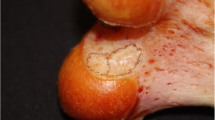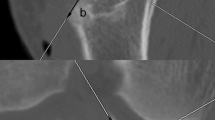Abstract
Purpose
When the femoral tunnel socket is reamed in an oblique direction from the wall of inter-condylar notch in anterior cruciate ligament (ACL) reconstruction, the tunnel length can be shorter at the periphery than at the centre. Because surgeons can manipulate the direction of tunnel in the outside-in femoral tunnel drilling technique, this length mismatch would vary depending on the direction of the tunnel. The purpose of this study was to investigate this length mismatch when reamed in various directions.
Methods
In total of thirteen points were defined as femoral drilling entry points on concentric lines with 0, 1, 2, and 3 cm radius from the lateral epicondyle of a three-dimensional bone model from 40 subjects. Femoral tunnel drilling was simulated on the models by connecting the centre of the ACL footprint with each defined point on the lateral femoral surface. The mismatch length was measured between the centre and the shortest peripheral side of the tunnel socket.
Results
When the distance between the drilling entry point on the lateral femoral surface and the lateral epicondyle was increased to anterior proximal direction, there was a significant increase in the mismatch length. The mismatch length became more than 2 mm when the entry point was located more than 2 cm away from the lateral epicondyle.
Conclusions
When the drilling entry point is set far away from the lateral epicondyle, a significant increase was observed in tunnel length mismatch between the centre of the tunnel and its shortest peripheral side. Because the tunnel length is measured with a guide pin introduced at the centre of the tunnel before reaming in retrograde outside-in technique, this length mismatch could cause an overestimation of the tunnel length. Surgeons should recognise this mismatch when preparing the length of graft and socket to optimise the graft insertion length into the socket.

Similar content being viewed by others
References
Logan JS, Elliot RR, Wilson AJ (2012) TransLateral ACL reconstruction: a technique for anatomic anterior cruciate ligament reconstruction. Knee Surg Sports Traumatol Arthrosc 20(7):1289–1292. doi:10.1007/s00167-011-1745-0
Robin BN, Jani SS, Marvil SC, Reid JB, Schillhammer CK, Lubowitz JH (2015) Advantages and disadvantages of transtibial, anteromedial portal, and outside-in femoral tunnel drilling in single-bundle anterior cruciate ligament reconstruction: a systematic review. Arthroscopy 31(7):1412–1417. doi:10.1016/j.arthro.2015.01.018
Osti M, Krawinkel A, Ostermann M, Hoffelner T, Benedetto KP (2015) Femoral and tibial graft tunnel parameters after transtibial, anteromedial portal, and outside-in single-bundle anterior cruciate ligament reconstruction. Am J Sports Med 43(9):2250–2258. doi:10.1177/0363546515590221
Sutter EG, Anderson JA, Garrett WE Jr (2015) Direct visualization of existing footprint and outside-in drilling of the femoral tunnel in anterior cruciate ligament reconstruction in the knee. Arthrosc Tech 4(2):e107–e113. doi:10.1016/j.eats.2014.11.017
Matsubara H, Okazaki K, Osaki K, Tashiro Y, Mizu-Uchi H, Hamai S, Iwamoto Y (2014) Optimal entry position on the lateral femoral surface for outside-in drilling technique to restore the anatomical footprint of anterior cruciate ligament. Knee Surg Sports Traumatol Arthrosc. doi:10.1007/s00167-014-3460-0
Niki Y, Nagai K, Harato K, Suda Y, Nakamura M, Matsumoto M (2015) Effects of femoral bone tunnel characteristics on graft-bending angle in double-bundle anterior cruciate ligament reconstruction: a comparison of the outside-in and transportal techniques. Knee Surg Sports Traumatol Arthrosc. doi:10.1007/s00167-015-3761-y
Lubowitz JH, Akhavan S, Waterman BR, Aalami-Harandi A, Konicek J (2013) Technique for creating the anterior cruciate ligament femoral socket: optimizing femoral footprint anatomic restoration using outside-in drilling. Arthroscopy 29(3):522–528. doi:10.1016/j.arthro.2012.10.007
Tomihara T, Hashimoto Y, Taniuchi M, Shimada N (2015) Relationship between femoral tunnel location and graft bending angle in outside-in and transportal technique for ACL double bundle reconstruction in 3D-CT study. Arch Orthop Trauma Surg 135(6):839–846. doi:10.1007/s00402-015-2226-6
Kim JG, Wang JH, Ahn JH, Kim HJ, Lim HC (2013) Comparison of femoral tunnel length between transportal and retrograde reaming outside-in techniques in anterior cruciate ligament reconstruction. Knee Surg Sports Traumatol Arthrosc 21(4):830–838. doi:10.1007/s00167-012-2024-4
Osaki K, Okazaki K, Matsubara H, Kuwashima U, Murakami K, Iwamoto Y (2015) Asymmetry in femoral tunnel socket length during anterior cruciate ligament reconstruction with transportal, outside-in, and modified transtibial techniques. Arthroscopy 31(12):2365–2370. doi:10.1016/j.arthro.2015.06.026
Okazaki K, Matsubara H, Osaki K, Tashiro Y, Mizu-Uchi H, Hamai S, Doi T, Iwamoto Y (2014) Femoral tunnel apertures on the lateral cortex in anterior cruciate ligament reconstruction: an analysis of cortical button fixation. Arthroscopy 30(7):841–848. doi:10.1016/j.arthro.2014.03.004
Ferretti M, Ekdahl M, Shen W, Fu FH (2007) Osseous landmarks of the femoral attachment of the anterior cruciate ligament: an anatomic study. Arthroscopy 23(11):1218–1225. doi:10.1016/j.arthro.2007.09.008
Shino K, Suzuki T, Iwahashi T, Mae T, Nakamura N, Nakata K, Nakagawa S (2010) The resident’s ridge as an arthroscopic landmark for anatomical femoral tunnel drilling in ACL reconstruction. Knee Surg Sports Traumatol Arthrosc 18(9):1164–1168. doi:10.1007/s00167-009-0979-6
Zantop T, Ferretti M, Bell KM, Brucker PU, Gilbertson L, Fu FH (2008) Effect of tunnel-graft length on the biomechanics of anterior cruciate ligament-reconstructed knees: intra-articular study in a goat model. Am J Sports Med 36(11):2158–2166
Mariscalco MW, Magnussen RA, Mitchell J, Pedroza AD, Jones MH, Andrish JT, Parker RD, Kaeding CC, Flanigan DC (2015) How much hamstring graft needs to be in the femoral tunnel? A MOON cohort study. Eur Orthop Traumatol 6(1):9–13
Author information
Authors and Affiliations
Corresponding author
Rights and permissions
About this article
Cite this article
Okazaki, K., Osaki, K., Nishikawa, K. et al. Overestimation of femoral tunnel length during anterior cruciate ligament reconstruction using the retrograde outside-in drilling technique. Arch Orthop Trauma Surg 136, 1159–1163 (2016). https://doi.org/10.1007/s00402-016-2492-y
Received:
Published:
Issue Date:
DOI: https://doi.org/10.1007/s00402-016-2492-y




